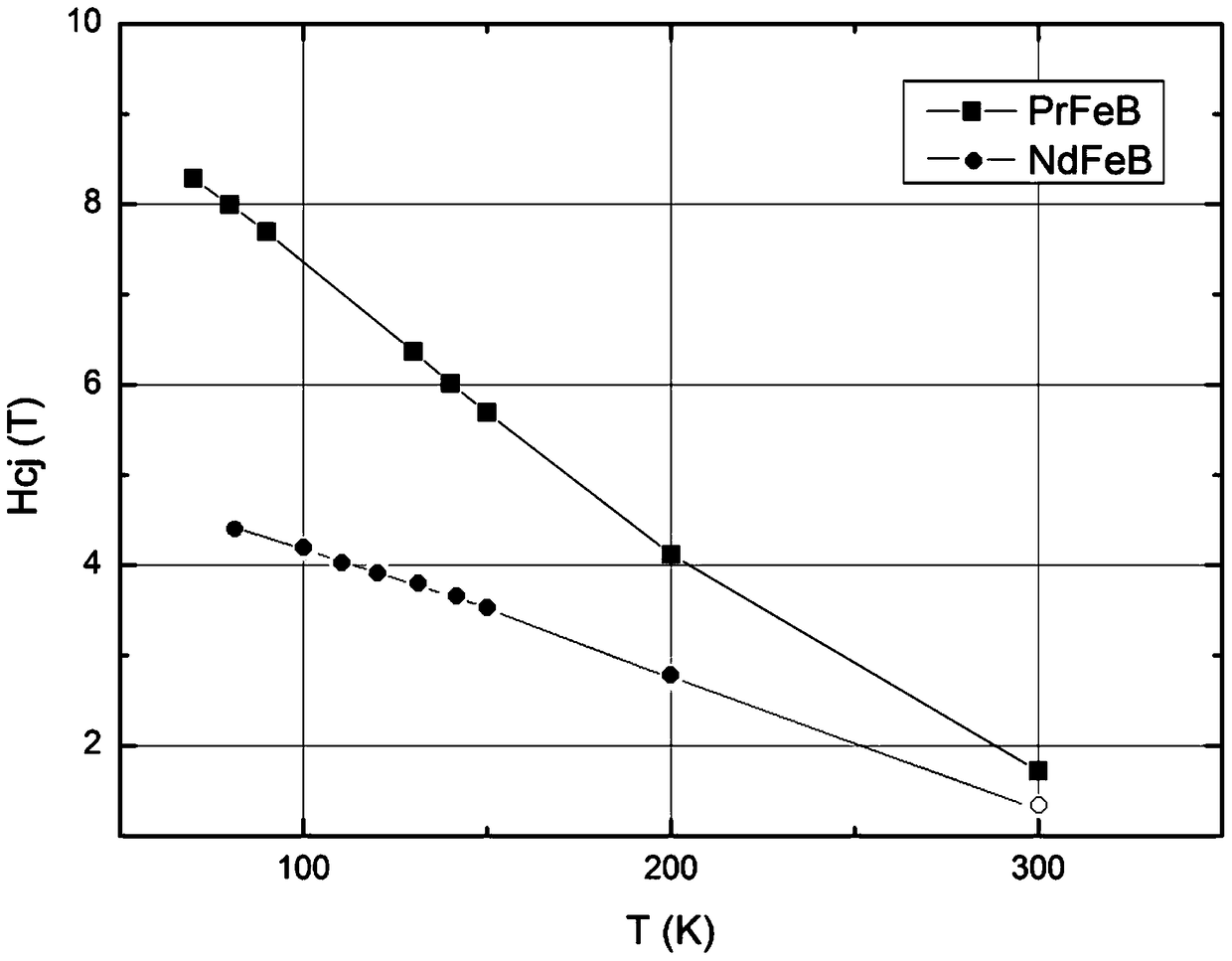Sintered praseodymium iron boron permanent magnet material and production method thereof
A technology of praseodymium iron boron and permanent magnets, which is applied in the direction of magnetic materials, magnetic objects, inorganic materials, etc., can solve the problems of low melting point, narrow tempering process range, difficulty in obtaining magnets with high coercive force, etc., and achieve high coercivity The best effect of coercive force and magnetic field
- Summary
- Abstract
- Description
- Claims
- Application Information
AI Technical Summary
Problems solved by technology
Method used
Image
Examples
Embodiment 1
[0042] 1. Preparation of praseodymium-iron-boron magnets
[0043] In the first step, the following raw materials are prepared by weight percentage: 31% of Pr, 1% of Dy, 0.1% of Al, 0.3% of Co, 0.08% of Cu, 0.12% of Ga, 0.96% of B and the balance of Fe . The above raw materials are melted in a vacuum strip furnace to obtain a strip alloy sheet with a thickness of 0.1-0.5mm.
[0044] In the second step, the strip alloy sheet is subjected to hydrogen crushing treatment, and then micropowder is prepared in a jet mill, and the average particle size of the micropowder is controlled at 4.0 μm.
[0045] In the third step, the fine powder is mixed in a container filled with nitrogen, and then the mixed fine powder is pressed into a blank under the protection of an inert gas. The orientation magnetic field of the press is ≥2T, and the size of the electromagnet pole head is greater than or equal to 1.3 times the gap size in the orientation direction of the mold. At the same time, when ...
Embodiment 2
[0062] In the first step, the following raw materials are prepared by weight percentage: 27% of Pr, 3% of Nd, 0.5% of Dy, 0.5% of Tb, 0.4% of Al, 0.3% of Co, 0.1% of Cu, 0.2% of Ga , 1% of B and the balance of Fe. The strip alloy sheet is obtained by smelting in a vacuum strip furnace, and the thickness of the strip alloy sheet is 0.1-0.5 mm.
[0063] In the second step, the strip alloy flakes are first subjected to hydrogen crushing treatment, and then fine powder is prepared in a jet mill, and the average particle size of the fine powder is controlled at 3.5um.
[0064] In the third step, the fine powder is mixed in a container filled with nitrogen, and the mixed fine powder is pressed into a blank under the protection of an inert gas. The orientation magnetic field of the press is ≥2T, and the size of the electromagnet pole head is greater than or equal to 1.3 times the size of the gap in the mold orientation direction. At the same time, when installing the mold, ensure th...
Embodiment 3
[0071] In the first step, the following raw materials are prepared by weight percentage: 25% of Pr, 4% of Nd, 0.3% of Tb, 0.1% of Al, 0.98% of B and the balance of Fe. The above raw materials are smelted in a vacuum strip furnace to obtain an alloy, and the thickness of the strip alloy sheet is 0.1-0.5mm.
[0072] In the second step, the strip alloy flakes are first subjected to hydrogen crushing treatment, and then fine powder is prepared in a jet mill, and the average particle size of the obtained fine powder is controlled at 3.0um.
[0073] In the third step, the fine powder is mixed in a container filled with nitrogen, and the mixed fine powder is pressed into a blank under the protection of an inert gas. The orientation magnetic field of the press is ≥2T, and the size of the electromagnet pole head is greater than or equal to 1.3 times the size of the gap in the mold orientation direction. At the same time, when installing the mold, ensure that the center of the magnetiza...
PUM
| Property | Measurement | Unit |
|---|---|---|
| thickness | aaaaa | aaaaa |
| particle size | aaaaa | aaaaa |
| density | aaaaa | aaaaa |
Abstract
Description
Claims
Application Information
 Login to View More
Login to View More - R&D
- Intellectual Property
- Life Sciences
- Materials
- Tech Scout
- Unparalleled Data Quality
- Higher Quality Content
- 60% Fewer Hallucinations
Browse by: Latest US Patents, China's latest patents, Technical Efficacy Thesaurus, Application Domain, Technology Topic, Popular Technical Reports.
© 2025 PatSnap. All rights reserved.Legal|Privacy policy|Modern Slavery Act Transparency Statement|Sitemap|About US| Contact US: help@patsnap.com


